
FROZEN SHOULDER, HOW PHYSICAL MANUAL THERAPY CAN HELP?
FROZEN SHOULDER: HOW PHYSICAL MANUAL THERAPY CAN HELP TREAT SHOULDER PATHOLOGY: DISCUSSING HOW CONVENTION TREATMENT CAN HELP ALLEVIATE SYMPTOMS
A comprehensive guide pain management & reducing stiffness in the Shoulder Joint and increase Shoulder Range of Motion without pain –
What’s Frozen Shoulder? Adhesive Capsulitis more commonly known as Frozen Shoulder injury is considered as a very common upper limb injury due to it can impair swelling, stiffness, dysfunction and irritation of the tissues that surround the joint; these are ones linked to frozen shoulder symptoms. Thus, it can be yielded after a minor trauma and following a shoulder surgery as well, where it is reported 5% up to 10% incidence, SportsMedBiologic stated.
So, How painful is frozen shoulder? This disease of the shoulder tissues can be very painful and disabling. This usually ends in a complete resolution of the condition if it is treated early with primary care conducted by Sports Injury Physiotherapy experts in Manchester.

The term frozen shoulder, which refers to a condition that physiologically implies an increase in the volume of the connective tissue of the shoulder was first introduced by Ernest Codman in 1934 who described it as a distinctly painful condition, where a noticeable lack of movement is experienced in the entire upper arm area and difficulty whilst sleeping on the affected side too.
A research study where 223 patients were observed showed that 20% of the patients claimed to have experienced bilateral pain, that is in both shoulders, in contrast with the fact that 59% only claimed to feel pain in one of the shoulders, most of the patients (91%) complained of mild pain and only 6% reported severe pain, said by Campbell Hand et la (2007).
Furthermore, it was also added the marked decrease in elevation, external rotation, and forward mobility, which are the characteristics of this condition.
An error that is commonly made during physical clinical assessment practices is to classify any condition of pain and stiffness in the shoulder as frozen shoulder; this is a very specific condition and has a resolution that is usually spontaneous, in addition, it has a different management approach in comparison to other shoulder diseases, pointed out by Steven Cutts et la (2005). If you are experiencing such symptoms, It would be suitable to contact www.mysportsinjury.co.uk and book a medical consultation to seek a thorough assessment & examination to diagnose such shoulder injury.
Frozen shoulder versus Rotator Cuff, is there any difference?
Rotator Cuff Tear can be often mistaken for Frozen Shoulder as they are the most frequent shoulder pathologies whether in sporting events or day to day activities.
OrthoAtlanta explains that the main difference between these pathologies is when you suffer from Rotator Cuff you present limitation of your range of motion despite this you can help yourself by lifting it manually. On the other hand, when it comes to Frozen Shoulder you cannot lift your arm at certain points as is greatly aching, you will sustain limitation of the range of movement as well.
Frozen Shoulder condition has proven to cause limitation of the ROM which can be represented with the following average ROM parameters, when performing abduction movements 98° is presented, 33° is noticed in external rotation, 117° in flexion movements, and 18° is observed in internal rotation when shoulder is abducted at 90°, issued by Phil Page et la (2010).
How effective is the Conservative and Non-Conservative Treatment to Treating Frozen Shoulder?
Is Frozen Shoulder curable? Even with all the current research done it is hard to define if one treatment is better than the other because with both treatment programs the same outcomes can be obtained in a period of two to three years, so, it is worth bearing in mind that there is no a way into how to cure frozen shoulder quickly.
For Frozen Shoulder managed with conservative treatment the suggested time frame to cease the ailment could take up to six to nine months, however, it will depend on the patient and if is complying with the prescribed program, according to Johns Hopkins Medicine.
Additionally, if you will undergo through surgical procedure for Frozen Shoulder is crucial to know that the success rate is about 70% up to 80%, indicated in an article of Raleigh Orthopedic Surgery Center.
Furthermore, the recovery time frame after surgery could last up to 3 months or even more, there is no an exact recovery time, following non-conservative intervention is highly important to see a Sports Physiotherapist or / Sports Therapist to design a rehabilitation program that meets your needs since Orthopedic physicians and Sports Physiotherapy practitioners work jointly in this sort of case, Jonathan Cluett for VeryWellHealth website (2020).
However, the level of disability that can be developed during this time period must be considered to define whether surgical treatment using arthroscopic release and anesthesia can speed up and shorten the recovery process, claimed in a Royal College of Surgeons of England’s article by Sunil Sharma et la (2015).
The main stages in the development of this condition are three, the 1st one is known as the painful or “freezing phase” that normally lasts the first 8 months.
The 2nd phase is the “adhesive phase” that can last up to a year.
Finally, the “resolution phase” which is the 3rd one lasts between one year and 42 months where the patient recovers almost entirely the mobility and function of the shoulder, indicated by Harryman et la (2004).
Although some studies have shown that the typical recovery period is one to three years, other studies point out that a significant percentage of people have had symptoms for up to a decade, so, we could say this condition could be substantially recurring.
It should be noted that surgical treatment does not usually have a schedule to be performed; this is taken into account after having used conservative frozen shoulder treatment and did not work out how it was expected, during conservative treatment it should be clear that the manipulation should be performed by stabilising the shoulder scapula. Manual Physical Therapy can be an essential part of this healing process to speed recovery rates in more younger people.
Does Physical Therapy Manchester really help Frozen Shoulder?
Accordingly to research studies, Physical Therapy Manchester does really help thaw Frozen Shoulder, approximately more than 90% of the cases can be wholly treated following a conservative treatment program. The best allies to unfreeze it are your physical therapy practitioner who will help restore movement in order to achieve live pain free and of course time is also vital in the healing process, posted by InMotion.

How common is Frozen Shoulder in the general population and who are more likely to suffer from it?
When the term frozen shoulder was first introduced by Codman, he also set out that one of its characteristics is the difficulty to explain it from a pathological point of view and difficult to treat, curiously after several decades this fact has not yet been significantly changed.
However, according to all the studies carried out around this disease in the general population, it is known that the incidence of frozen shoulder is 3% -5% nowadays, the age range where this condition is most experienced is from 30 up to 40, 50 years old, Hui Bin Yvonne Chan et la (2017) reported.
Interestingly, it is more common in women than in men and it has also been shown that diabetic people tend to suffer from this condition, is relevant to mention that frozen shoulder and diabetes are strictly linked, claimed by Lequesne M et la (1977) whereas patients with systemic diseases such as thyroid diseases and Parkinson’s disease are also prone to sustain frozen shoulder.
Why do Diabetic people suffer from this Frozen Shoulder condition?
This is because the exponential increase in blood glucose in diabetic patients tends to cause effects on the production of collagen that adheres to the shoulder, making it sticky due to sugar molecules; consequently the movement is restricted and limited yielding the shoulder to get tense and rigid. This physiological process can be described as glycosylation, according to an article of Diabetes.co.uk (2019).
Diabetic patients have reported to have the highest incidence worldwide reaching about 20% of all frozen shoulder affected subjects, Hai V. Le et la (2017).
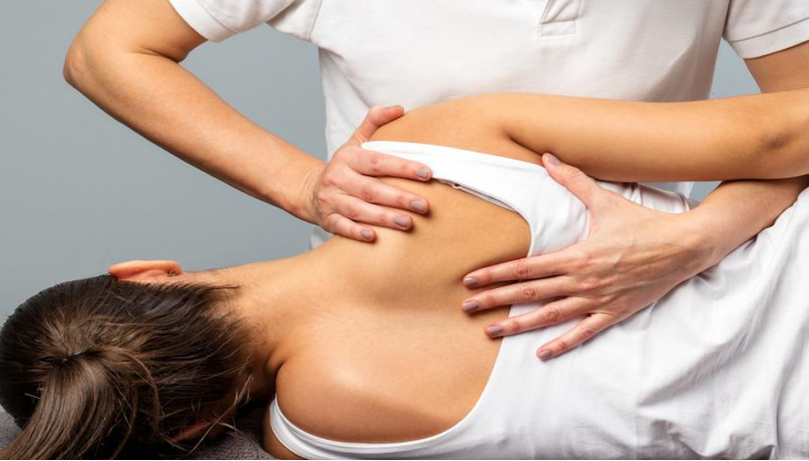
Athletes vs Frozen Shoulder which Sports are more likely to develop it?
The shoulder has a wide number of tissues, tendons, bones, and interconnected parts that make all its mobility and rotation possible, we use the shoulder throughout the day on a daily basis without even realising it and sometimes we subject our shoulders to physical challenges and a great tension especially when we practice sports, Sports Injury Bulletin affirmed.
For most athletes, frozen shoulder, as well as other conditions that affect the shoulder, have been a major and incessant problem, many factors that can cause the disease, there is evidence confirmed by athletes who claim that the shortening of one of the ligaments of the shoulder may increase.
You may wonder what causes a frozen shoulder, the risk of suffering from this condition may be due to poor posture, a serious sports injury come about by tackles, overuse, stress, collisions, repetitive and poor techniques, thereby some elite athletes also perform specific training to increase the muscle mass of the deltoids, and pectorals, thus shortening said ligament, these are ones of the frozen shoulder causes imparted by Results Physiotherapy.

Some sports such as baseball, softball, football, swimming, and tennis are the most likely to produce not only frozen shoulder but the majority of shoulder injuries that an athlete might suffer throughout their professional career.

How long is the recovery time after Conservative and Non-Conservative Frozen Shoulder treatment?
Much has been said about which of the two treatments has the best results and which speeds up the recovery process, it is well known that the first treatment to be carried out when faced with a diagnosis of frozen shoulder is the non-conservative one, where the Physical therapy plays a fundamental role, many patients have recovered full shoulder mobility, and stability with simple physical exercises accompanied by certain anti-inflammatory drugs and sometimes steroid injection for frozen shoulder, published by Mahsa Asheghan et la (2016).
A study published in the Maryland Medical Journal indicated that a total of 32 patients underwent therapeutic manipulation of the shoulder to treat frozen shoulder, these patients were observed for about 58 months to verify the time it would take for each to retrieve mobility and rotation.
The recovery time rate was 13 weeks, where 97% of the participants claimed pain relief and recovery of the nearly utterly mobility, a small percentage needed a second period of therapy to be successful.
Another study done in 2004 in Norway showed that acupuncture is also a method that can speed up the recovery process, calming the intensity and frequency of pain, issued by Dong He et la (2004).
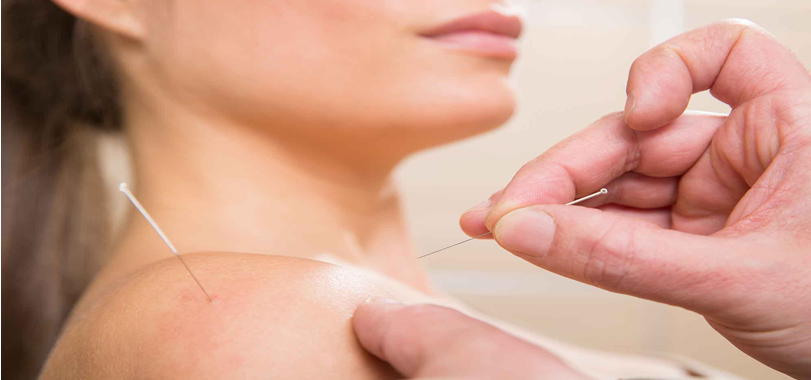
On the other hand, the postoperative recovery time after surgery for frozen shoulder also must be accompanied by physical rehabilitation processes.
Normally the recovery period is between 6 weeks or 3 months, it should be recalled that it is a slow and delicate process which must be carried out gradually with the specific physical therapy Manchester recommended by the sports physiotherapy Manchester specialists and clinicians.
How can Physical Therapy for Frozen Shoulder help alleviate symptoms at MY Sports Injury Clinic?
In our facility we provide several conservative treatment approaches which will help you maintain, restore and make the most of the client’s well-being, mobility, and function. Sports physiotherapy will assist you through injury prevention, health and fitness, sports massages, physical rehab, dry needling, acupuncture, and Osteopathy & Body Postural Rehabilitation.
How to fix Frozen Shoulder pain based on Physical Therapy and Self-Care via home program?
The objective of these exercises for adhesive capsulitis or frozen shoulder will be to work the mobility of the shoulder in a global way through therapeutic homework, with the least pain allowed. Little by little, you will try to achieve a greater range of motion, which will allow you to advance in pain tolerance.
If shoulder pain conditions our life, causes us stiffness, limitation and other daily problems, it is essential to perform this series of exercises for adhesive capsulitis, where the objectives are:
- Relieve and reduce the pain that it causes us.
- Gain range of motion and remove limitations.
- Strengthen the muscles of the area weakened by capsulitis in the shoulder.
Once we have put this routine for frozen shoulder pain into practice and do this routine for frozen shoulder pain on a daily basis, we may be interested in supplementing this information with exercises for shoulder injury such as bursitis, rotator cuff, tendonitis, and so on, which will help us complete the process of fine-tuning the area, relieving and eliminating any shoulder pain.
What are the best home exercises suggested by Sports Physiotherapy Manchester Specialists in order to enhance range of motion and ease discomfort in the Shoulder?
Sometimes it is originated by an idiopathic nature and many times of unknown causes leading to the frozen shoulder consequences; it can be one of the most frequent complications after shoulder surgery.
If we have discomfort and shoulder pain, these home exercises for adhesive capsulitis will be carried out at specific times throughout the day and in order to see progress little by little.
When we get up and before going to bed, and you can even practice them in the midday, when it comes to a more phase Advanced Capsulitis in the shoulder.
The repetitions of the exercises for adhesive capsulitis will be carried out for 30 minutes, increasing by 5 minutes each week in the work series until reaching 1 minute each and we can do them anywhere as long as we have a broomstick or elongated object and a comfortable seat, and if there is a possibility, a ball will be also needed.
Exercises for frozen shoulder uk that work capsulitis in the shoulder for shoulder pain will help us to mitigate or alleviate the limitation and stiffness that this pathology often produces.
These exercises for Adhesive Capsulitis should be daily movements that will help us strengthen the muscles and gain range of motion as well, even in most cases eliminating complete stiffness and not the rotation and extension of the shoulder.
These frozen shoulder exercises or shoulder pain exercises are designed and put into practice by our team of Physiotherapists at My Sports Injury Clinic in Manchester City.
The exercises for frozen shoulder are carried out in the early stages of rehabilitation alongside with Physiotherapy approaches adapted and focused on the Capsulitis injury in the shoulder.
- Exercise 1
Flexion with a broomstick
We begin the exercises for frozen shoulder with the hands at shoulder height, hold a broomstick horizontally in front of the body, and lift with the elbows extended as far as possible.
To keep in mind, avoid compensations by controlling the position of the shoulders, without shrugging. Maintain the movement for 30 seconds, do 10 reps and 3 series.
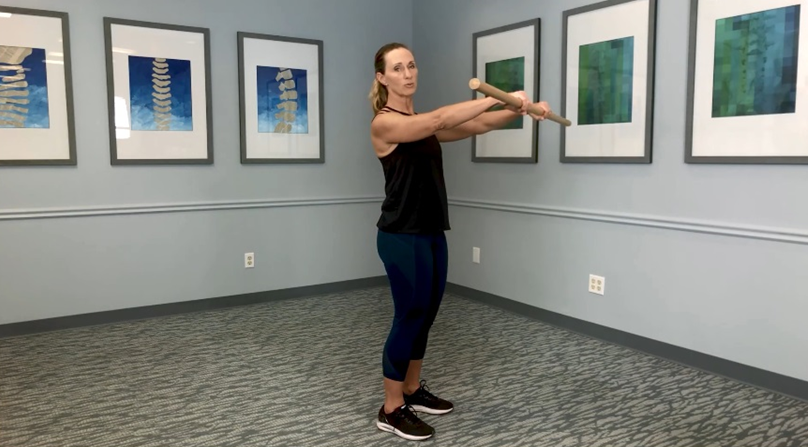
- Exercise 2
Extension with a broomstick
Take the broomstick or pole horizontally from behind your body, with your elbows extended, and lift the pole or broomstick back. Maintain the movements repetitively for 30 seconds even if we feel slight shoulder pain. Do 10 reps and 3 series.
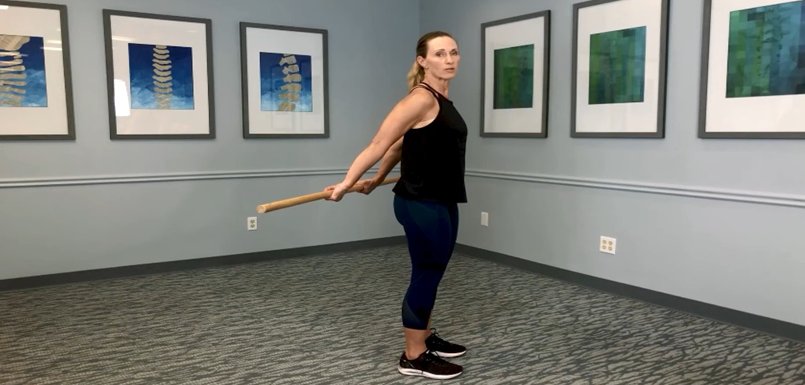
- Exercise 3
Internal rotation with a broomstick for frozen shoulder
Take a broomstick horizontally from behind your body, close to your body, and drag it down your back as if you were scratching your back. To progress, get closer to the grip of the hands. Maintain the movements for 30 seconds, do it 10 times and 3 series.
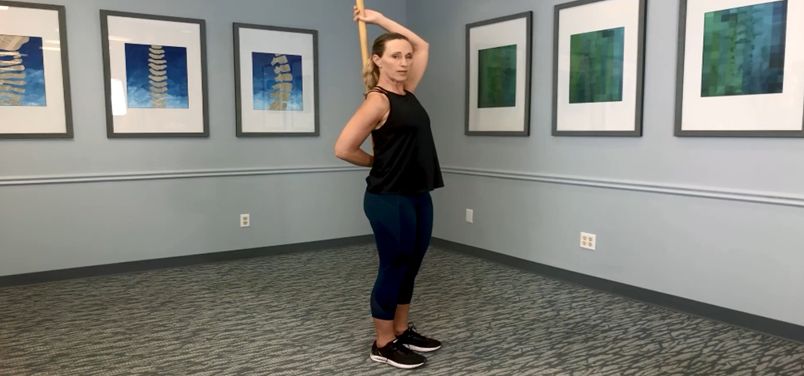
- Exercise 4
Codman pendulum
Supporting the unaffected side on a table, release the affected shoulder and perform light rocking, taking advantage of the weight of the body. In this way, we try to mobilize the shoulder in small circles, to free the joint space. Hold 30 seconds. Do 3 reps and 1 series.
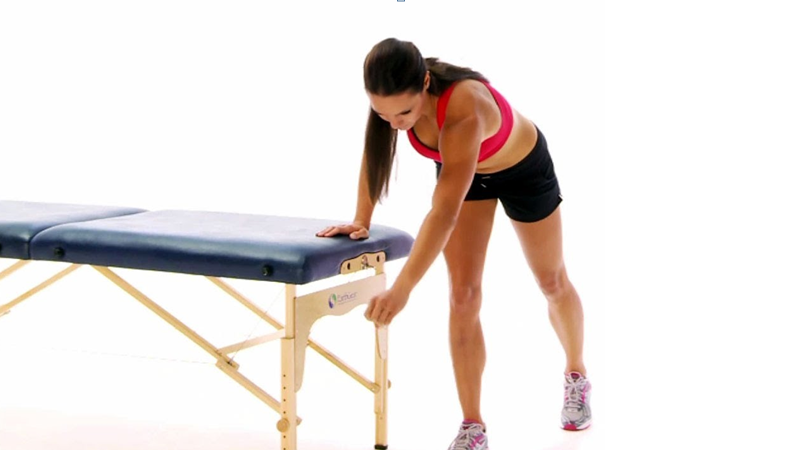
- Exercise 5
Flexion-extension with a rubber or normal ball
Sitting next to a table, roll the ball back and forth to flex the arm. To improve our capsulitis in the shoulder, maintain the back and forth position of the arm for 30-40 seconds. Do 3 reps and 1 series.
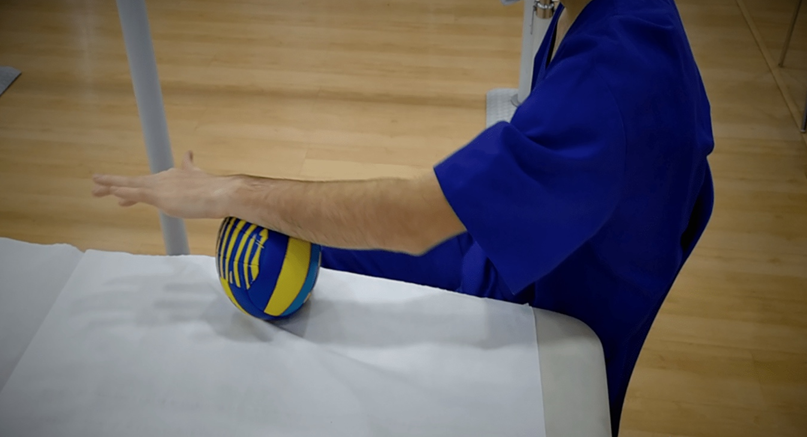
The prime takeways about this Frozen Shoulder Article
Frozen shoulder is the involvement of the shoulder capsule, which becomes thicker and more fibrous. The pain in the shoulder joint and limitation of range of motion are the biggest problems resulting from adhesive capsulitis. Adhesive capsulitis follows three phases freezing, freezing, and thawing and can take up to 24 months to resolve. Both Conservative and Non-Conservative treatments are effective, when the conservative one fails; a surgical process must be considered. The typical treatment includes the use of ice therapy, anti-inflammatory medications, and physical therapy Manchester. The physical therapist Manchester practitioners will give you an exercise routine to help regain your range of motion and function.
Published by Rafael Peña for www.mysportsinjury.co.uk/blog
References
- Chan HBY, Pua PY, How CH. Physical therapy in the management of frozen shoulder. Singapore Med J. 2017;58(12):685-689. doi:10.11622/smedj.2017107.
- Lesquesne M, Dang N, Benasson M, Mery C. Increased association of diabetes mellitus with capsulitis of the shoulder and shoulder–hand syndrome. Scand J Rheumatol 1977; 6: 53–56.
- Codman EA. The Shoulder 1934; Boston, USA: Thomas Todd.
- Reeves B. The natural history of the frozen shoulder syndrome. Scand J Rheumatol 1975; 4: 193–196.
- Dennis L, Brealey SRangan A, et al. Managing idiopathic frozen shoulder: a survey of health professionals’ current practice and research priorities. Shoulder & Elbow 2010; 2: 294–300.
- Linaker, Catherine H, and Karen Walker-Bone. “Shoulder Disorders and Occupation.” Best Practice & Research. Clinical Rheumatology, U.S. National Library of Medicine, June 2015.
- Asheghan M, Aghda AK, Hashemi E, Hollisaz M. INVESTIGATION OF THE EFFECTIVENESS OF ACUPUNCTURE IN THE TREATMENT OF FROZEN SHOULDER. Mater Sociomed. 2016;28(4):253-257. doi:10.5455/msm.2016.28.253-257.
- He D, Veiersted KB, Høstmark AT, Medbø JI. Effect of acupuncture treatment on chronic neck and shoulder pain in sedentary female workers: a 6-month and 3-year follow-up study. Pain. 2004;109(3):299–307.
- Le HV, Lee SJ, Nazarian A, Rodriguez EK. Adhesive capsulitis of the shoulder: review of pathophysiology and current clinical treatments. Shoulder Elbow. 2017;9(2):75-84. doi:10.1177/1758573216676786.

